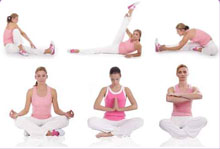Jala Neti (Nasal Cleansing)
Jala neti kriya is an ancient technique of yoga, which literally means ‘water cleansing’.
Though jala neti is not prevalent in the West, it is practiced commonly in parts of India and other parts of South East Asia.
Nasal cleansing or neti kriya is one among the other shat karmas or the hatha yoga cleansing activities. The cleaning of the nasopharyngeal tract is usually performed in one of two different methods. One method is through nasal irrigation with warm saline solution. This method is called jala neti. The other method is with a cotton thread called sutra neti.
Jala Neti Pot
There are certain factors that need to be considered for jala neti to produce effective results. The water directed into the nostril should be at the correct pressure so that it can create the necessary effect. The level of water should also be of a certain quantity to irrigate the nasal passages sufficiently and also to create a correct flow pressure. While the neti pot is the perfect tool to bring about these results, it is best to learn as much as you can about the neti pot before attempting this.
When buying a neti pot ensure that:
- The neti pot is able to contain 500 ml of water. This amount is necessary to flush your sinuses sufficiently with the desired pressure.
- The end of the neti pots spout is tapered so that it plugs the inlet nostril.
Saline water is usually used as a neti pot solution. Ideally you should use sea salt; however, the other kinds of salt you could use are as follows:
- Pickling salt
- Table salt
- Vegetable salt
- Rock salt
- Kosher salt
- Macrobiotic salt
Knowing how to use the neti pot properly will prevent you from experiencing any neti pot dangers. One of the dangers of the neti pot is a burning sensation.
This can happen if you use the wrong temperature of water, wrong amount of salt or wrong kind of salt. It is best to consult a yoga practitioner and learn this technique properly before trying it out at home.
Jala Neti Procedure
The jala neti method is performed in three stages.
- In the first stage, you should let the water flow up one nostril so that it reaches just above the bridge of the nose, goes back into the middle cavity and flows out though the other nostril.
- In this stage, there should not be any water flow to the mouth or throat.
- Stages two and three should be attempted only after you can perform stage one perfectly.
- In these stages, the flow of water is through the entire nasal cavity, down the nasopharynxs’ back and out the mouth.
- To avoid any damage or discomfort to the nasal functions make sure that you follow the jala neti instructions properly.
Jala Neti Benefits
- It is beneficial for illnesses like bronchitis and asthma as it reduces the tendency to breathe from the mouth by cleaning the mucus from the nostril.
- It is effective for certain kinds of ear disorders like tinitis, glue ear, and middle ear infections.
- Neti pots for sinus infections can also be used effectively as a natural remedy.
- The olfactory’s nerves sensitivity is improved, therefore restoring a sense of smell that was lost.
- It has a soothing and cooling effect on the brain by eliminating excess heat, and it is therefore an effective remedy for depression, hysteria, temper tantrums, epilepsy, migraines, and headaches.
- It helps bring about better concentration and mental clarity.
- It helps to get rid of all the harmful bacteria in the nasal cavity.
 Find Pose
Find Pose

